Teva Motors launches
Page 8

If you've noticed an error in this article please click here to report it so we can fix it.
7.5-tonne battery truck... By David Wilcox
A NEW UK company is building what it claims will be the first practical, economically viable, lowemission 75-tonne GVVV truck.
Teva Motors, set up by entrepreneur Asher Bennett (pictured), is developing the vehicle using a Chinese-supplied cab and chassis.
Bennett said that whereas other battery vehicles have focused on emissions, Teva prioritises range, payload and operating costs above emissions, thus ensuring that it is a practical proposition.
The Chinese truck's diesel driveline is replaced by an electric motor, bank of lithium-ion batteries and a controller. Batteries will be charged at base overnight, from a mains charger. "Using cheap, night-time electricity is an important part of our strategy," said Bennett. But Teva's truck is a cross between a battery vehicle and a series hybrid, so includes a small (1.6-litre) diesel engine, which, along with a regenerative braking system, charges the batteries during the working day,
extending the truck's range.
"Pure electric vehicles make no sense," claimed Bennett, "because their range is so limited. If you can only do 50 miles a day, the emissions savings aren't worth it." Teva uses software modelling of
the daily duty cycle to run the engine proactively, before battery charge sinks too low. "It will work best with a daily range of 50 to 200 miles," said Bennett, adding that the payload will be only 100kg to 150kg less than a diesel 7.5-tonner.
He claimed that even with new battery costs factored in after six to seven years, this range-extended battery truck will be cheaper to operate than a diesel, easily recouping its capital premium.
Although the chassis-cab is from China, driveline development will be done in the UK, as will its installation.
The prototype is due for completion by the middle of next year, with production scheduled for the end of 2015.













































